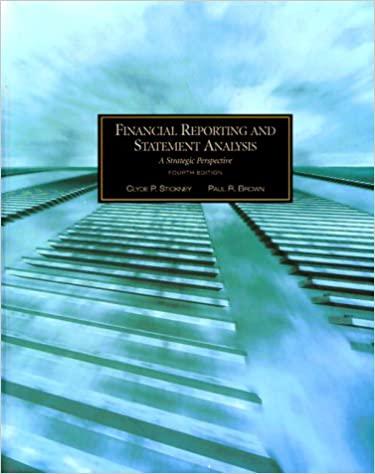Question
Year Units Sold 1 65,000 2 93,000 3 120,000 4 110,000 5 83,000 6 50,000 Price per Unit = $260.00 Variable Cost per unit =
| Year | Units Sold |
|
|
|
| 1 | 65,000 |
| 2 | 93,000 |
| 3 | 120,000 |
| 4 | 110,000 |
| 5 | 83,000 |
| 6 | 50,000 |
- Price per Unit = $260.00
- Variable Cost per unit = $125.00
- Fixed Costs = $255,000.00
- Taxes = 36%
- Cost of Equipment = $33,200,000.00
- Shipping and Installation Costs = $1,000,000.00
- Increase in Working Capital = $150,000.00
- Salvage Value = $80,000.00
- Life of Equipment = 6 years.
- Sales Price (End of Useful Life of Project Equipment) = $30,000.00
- Required Return Rate (for NPV and IRR Calculation) = 17%
Use the information above to calculate the following for this 6-year Capital Budgeting Project:
- Annual Cash Flows for Years 1-6
- the Initial Outlay in Year 0
- the Depreciable Base
- Depreciation Expense (Straight Line)
- Proceeds from Sale of Equipment (aka Cash Flow from Sale at end of useful)
- CF Total from the Terminal Year 6
- the Net Present Value (NPV) of the Cash Flows for years 1-6
- the IRR (Internal Rate of Return)
Your answers should be inputted as follows:
Annual Cash Flows for Years 1-6.
- Year 1=
- Year 2=
- Year 3=
- Year 4=
- Year 5=
- Year 6=
- Initial outlay =
- Depreciable base =
- Depreciation Expense =
- Proceeds from Sale of Equipment =
- CF Total from the Terminal Year 6 =
- NPV =
- IRR =
- Proceed with project? Yes or No.
Helpful Hints:
For each year/period you will calculate an Income Statement (or Annual Cash Flows) using:
- Revenue
- Variable Cost
- Fixed Cost
- Depreciation Expense
- EBIT
- Taxes
- Net Income
- Add: Depreciation Expense
- Annual Cash Flow
I would recommend using a spreadsheet to calculate the annual cash flows for years 1-6. If you know the formulas for NPV and IRR in Excel, use them. The Excel formula for NPV is: NPV=(Rate, Values [Annual Cash Flows from years 1 to ]) + the Initial Outlay (Time 0 is added here because the initial outlay value is negative. In other words, adding a negative value will ultimately subtract the initial outflow of cash from the annual cash inflows). Input the rate as a decimal: .17. For IRR, IRR=(Values). I would recommend using your financial calculator for NPV and IRR, which is a lot simpler in my opinion.
Remember to calculate Depreciation Expense and use it to calculate your tax liability and then to add it back in (because its a non-cash expense) to calculate Annual Cash Flow.
Remember also our assumption of Working Capital: that we recapture (or earn it back) in the terminal year.
You will also need to calculate the Proceeds from the Sales of Equipment and depending on whether or not its a gain or loss, youll have either a tax shield or a tax liability in the terminal year. After you calculate your tax gain or loss, you add or subtract that to the sales price to get your proceeds from gain/loss from sale of equipment.
Remember that the Initial Outlay is a negative value and is required for NPV and IRR calculations. You will need to make sure that these values are appropriately positive or negative in Excel.
2. Suppose you have estimated the free cash flows to the firm over the next 5 years in the following way:
Year FCFF
- 1 $108 Million
- 2 $114 Million
- 3 $119 Million
- 4 $124 Million
- 5 $128 Million
You expect FCFF continue to grow at a constant rate of 5% per year, indefinitely, after year 5. If the companys weighted average cost of capital is 10%, then what is the value of the firm? Remember to add the Terminal Value (growing constantly at 5%) to the Year 5 Annual Cash Flow to find the Terminal Cash Flow, and then find the NPV.
Select one:
a. $2.897 Billion
b. $2.115 Billion
c. $2.129 Billion
d. $1.142 Billion
e. $1.289 Billion
A firm has Sales of $6,000, variable costs of $2,500, fixed costs of $1,200, depreciation of $900, and an interest expense of $350. What is the firms degree of combined leverage (DCL)?
Select one:
a. 12.25
b. 11.00
c. 14.00
d. 5.83
e. 2.40
Step by Step Solution
There are 3 Steps involved in it
Step: 1

Get Instant Access to Expert-Tailored Solutions
See step-by-step solutions with expert insights and AI powered tools for academic success
Step: 2

Step: 3

Ace Your Homework with AI
Get the answers you need in no time with our AI-driven, step-by-step assistance
Get Started


